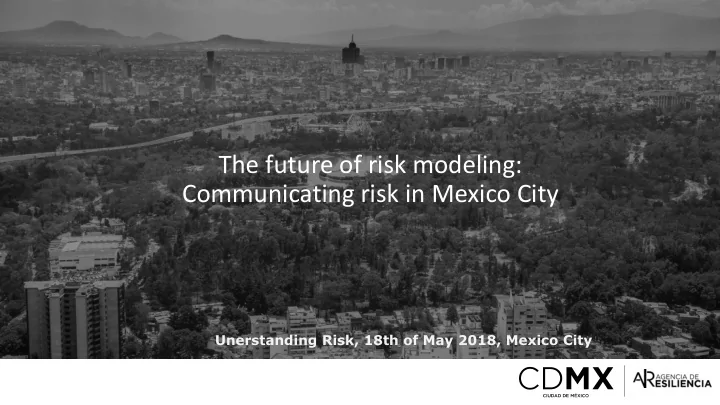

The future of risk modeling: Communicating risk in Mexico City Unerstanding Risk, 18th of May 2018, Mexico City
Multiple risks due to Social and spatial inequality Integrated long-term geographic location and & high vulnerability to planning & regional socio-economic context. climate change. coordination.
Risk data integration in CDMX • National Risk Atlas • National Climate Change Vulnerability Atlas • Mexico City´s Risk Atlas
Key issues where risk modeling can transform the city • Facing multiple risks: earthquakes, subsidence, climate change, etc … • Increase resilience towards flooding and the potential collapse of the sewage system • Emergency planning and response • Address socioeconomic conflicts and security • Improve the mobility system
Examples of how we use data to plan INTELLIGENT MOBILITY: TRANSFORMING MOBILITY THROUGH DATA • Mexico City launched the Vision Zero Initiative to reduce fatalities related to transit accidents. The mobility control centre will include all databases and it’s an opportunity for monitoring, measuring and improving road safety. • Mapaton: 30,000 buses perform 14 million trips daily and there is no tool that recognizes these routes. LabCDMX developed Mapaton, a Map by Laboratorio crowdsourcing and participatory mapping para la Ciudad, Isaax Serrano 2016 excercise where 3557 users built 2,102 routes.
Examples of how we can use data to plan WATER MANAGEMENT: • Floods are recurrent in CDMX. Data can help understand areas prone to flooding, intensity, and population at risk to design plans and projects. • Data can also provide key information to define triggers for innovative insurance schemes.
Examples of how we can use data to plan • Quantify the current resilience of the city. • Set realistic goals for the future. • Identify where investments in resilience can be more productive. • Increase resilience of the city´s strategic public facilities.
Challenges • Reluctance to release data due to concerns over negative impacts and externalities. For example: • Impact on the real estate market • Creating social demands without comprehensive policy response. • National security concerns. • Lack of data • Ownership of data is power. • Low incentives for the scientific community to share data. • Level of trust from citizens
Lessons learned from 19S Earthquake • Focus on high priority buildings. • Strengthen the most vulnerable components of the water distribution system. • Create redundant plans for the most strategic components of the public network system. • Create incentives to promote earthquake insurance for housing. • Strengthen communication with the citizens.
Recommend
More recommend